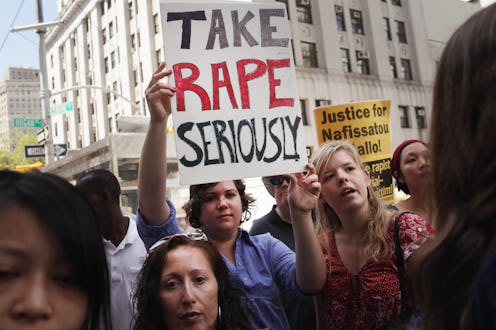If justice were really as transparent as we would all like it to be, none of the following facts would be surprising. But that's not how things work. Women have historically been trained to keep quiet on matters of sexual assault, a trend that is thankfully changing. Even still, more often than not, victims of assault face a mountain of criticism, doubt, and even blaming when and if they do choose to speak up. Their voices are silenced, or their assailant's crime ignored. Understanding the reality of sexual violence in America, and bringing a candid conversation about it to the forefront of our social dialogue, is an ongoing, not-at-all-yet-won battle.
That's not to say there isn't encouraging news to be had. Yes, the general public is becoming more aware in the past year not just of what constitutes sexual assault, but how prevalent it truly is among women. This is due partially to a handful of major cases that have garnered media attention: Lena Dunham recently opened up about her encounter with rape in her memoir, and Emma Sulkowicz of Columbia University has carried a mattress from class to class in protest of the school's refusal to expel her rapist, a student who has been accused of other sexual assaults in the past. Colleges around the nation have been accused of turning their back on rape, including my alum, the University of Virginia, the same university that has experienced the most likely linked disappearances of students Hannah Elizabeth Graham and Morgan Dana Harrington.
Hashtags like #YesAllWomen have made social media a platform for the public airing of the experiences of thousands of women. Suddenly, people have been able to see that sexual assault isn't just something that happens rarely, but is an ever-present reality to actual women who they actually know in their real lives. If nothing else, it can give us hope that sexual assault and rape are now issues that are being thought of as belonging to all of us, which they undoubtedly do.
I wish we didn't live in a world where people who commit these kind of heinous crimes exist, but as long as we do, doing better (as it always does) starts with knowing better. Because as much media attention as a few of these cases have gotten, there is still a lot the media hasn't talked about that is crucial to know. Here are 10 must-know facts about sexual assault and rape...
Sexual Violence Is Often Committed By Someone The Victim Knows
In 78% of sexual assault cases reported between 2005 and 2010, the assault was committed by someone the victim personally knew. And that’s just among the reportedassaults.
Rape Is Significantly Underreported in the U.S.
Perhaps because in the majority of instances rape occurs between two people who know each other, it is estimated that less than half of sexual assault and rape cases are reported. The National Crime Victimization Survey accounted for 188,380 cases of sexual assault and rape in the year of 2010, when the FBI only accounted for 85,593 reported cases.
Victims are Under the Age of 18 in 44% of Sexual Assaults
Those are children, you guys. And overall, 80% of victims are under the age of 30.
Most Sexual Assaults Take Place Between 6PM and 12AM
43% of assaults take place between 6PM and 12PM, 24% between 12AM and 6AM, and 33% between 6AM and 6PM.
Most Sexual Assaults Occur in the Victim's Home
In movies, it always seems like rape is some spontaneous thing that happens in dark alleys or streets, and sure, sometimes that is the case. But more often than not, sexual assault takes place somewhere familiar to the victim: 40% it’s the victim’s home, 20% of the time it’s the assaulter’s home, and 10% of attacks happen in parking garages.
Women Aren't The Only Ones Who Experience Sexual Assault
In fact, one out of every ten victims of sexual assault and rape are male. Men are less likely to report instances of rape, as the majority of sexual violence against men is committed by other men, and is typically more violent in nature.
College Campuses Have Much Higher Rates of Sexual Assault Than You Think
We've commonly heard that one in five girls on college campuses will experience rape or attempted rape during their college career, but a survey in 2013 indicated that the number is higher than that, with an estimated 20%-25% of female students (as many as one in four). Students are most at risk in their freshman and sophomore years.
Rapists Can Sue For Custody and Visitation
Ugh, this is some SVU shit and it’s bleak. If a rapist impregnates their victim, it is legal for him to sue for custody and visitation rights in 31 states in the U.S., a law which gives rapists the potential power to be in their victim’s lives against their will.
Instances of Rape Are Actually Declining
While we are nowhere near solving the problem, sexual assault rates have decreased by 50% since 1993, due to increased public awareness and vigilance. The Rape, Abuse, and Incest National Network estimate that the declining rates have prevented the sexual assault of 5.5 million Americans in the past twenty years.
The Number of Victims Whose "Fault" It Was
Still zero.
Images: Getty Images
